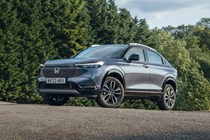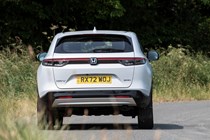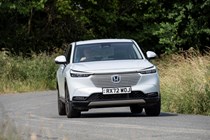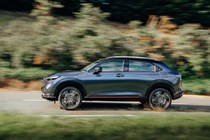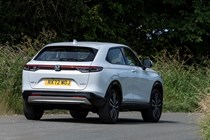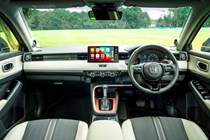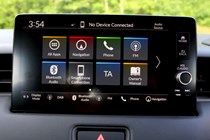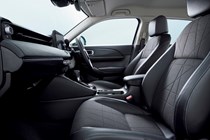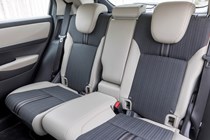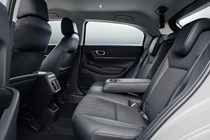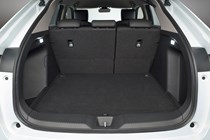
Honda HR-V long-term test
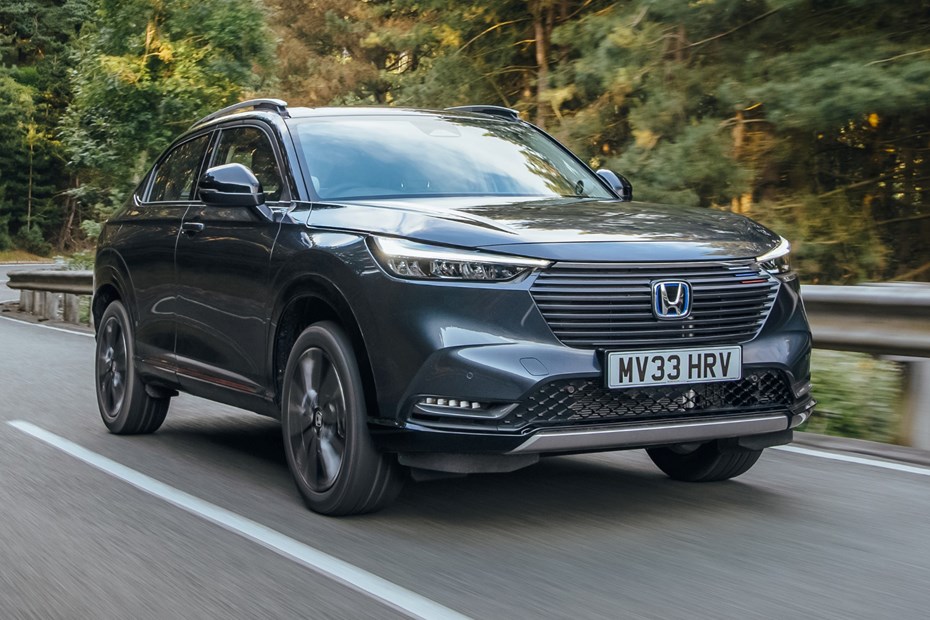
Now in its third generation, Honda’s pint-sized SUV has certainly come on in leaps and bounds since it appeared more in the guise of a jacked-up boxy estate car back in 1999. Parkers takes a look at how the new 2021- model range has evolved into a modern stylish family offering.
Update 1: Welcome
Update 2: Equipment and Options
Update 3: The Weekly Shop
Update 4: Driving Impressions
Update 5: Summing Up – Our Thoughts
Update 1: Welcome and Intro
Today, with a swathe of modern styling and oodles of best Japanese tech, the HR-V looks on the surface to be well pitched to grab a large slice of the smaller SUV market action. So how does the latest model stack up and what’s it like to be an owner for an extended period? Parkers ‘Product’ guru and resident radio ham Steve ‘Percy’ Lawman grabbed the keys from current F1 World Champion Max Verstappen to see how it all panned out.
2021 saw the third generation of Honda’s HR-V. On launch, the range had a single powertrain. The ‘e:HEV’ (Hybrid Electric Vehicle) which is also available in the current generation Jazz and CR-V, consisted of a petrol engine coupled with a dual electric motor, a 60-cell lithium-ion battery and an innovative fixed-gear transmission coupled to an intelligent power control unit.
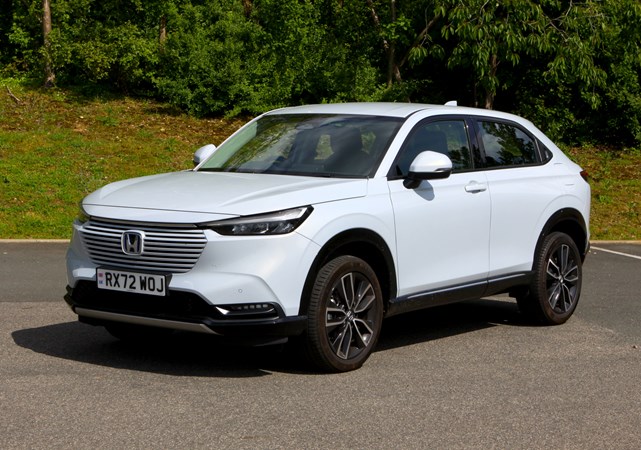
The 1.5-litre i-MMD 4-cylinder powertrain produces a total power output of 96kW (131PS), coupled with 253Nm of torque. It’s a self-charging hybrid and its battery pack cannot be recharged externally. CO2 emissions range from 122g/km (WLTP combined cycle) with an annual road tax at £170. Fuel economy is listed at 52.3mpg / 5.4L/100km and a 0-62mph in 10.6 seconds. The e:HEV set-up includes three interchangeable drive modes that are selected automatically according to the prevailing driving conditions.
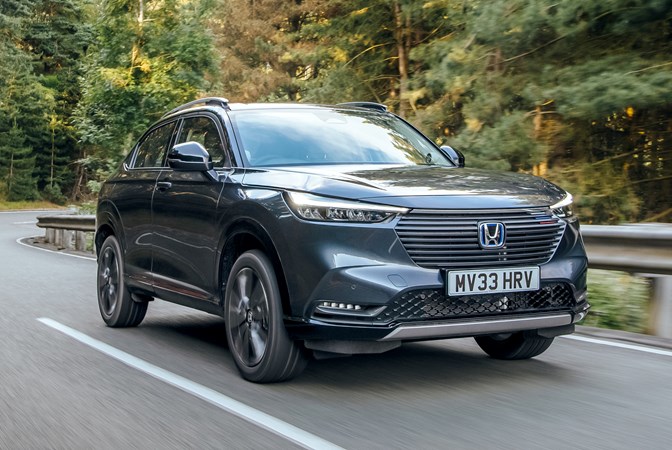
The HR-V in our opinion sits in the smaller size SUV arena and as such, has a swath of very capable competitors including the Vauxhall Mokka, Nissan Juke, Renault Captur, VW T-Roc and Parkers 2023 ‘Best Small Car’ award winner the Ford Puma. It’s also been compared to Nissan’s class leading Qashqai although we think the Qashqai is somewhat of a chunkier beast. Given the arena, it’s a super-tough environment and there’s no room for any slouches.
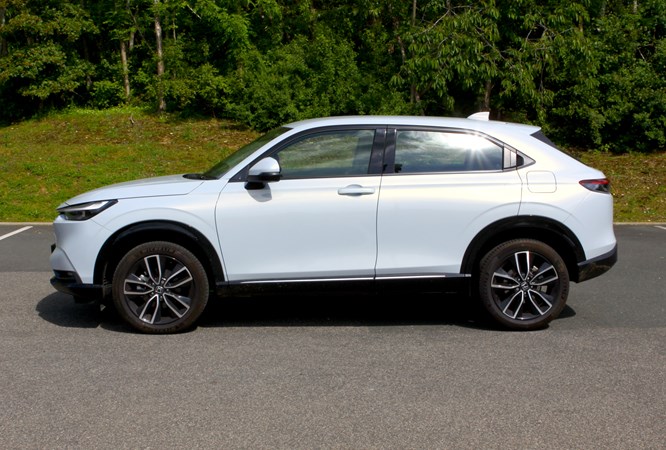
The new HR-V is available in three trim levels, Elegance (£30,115), Advance (£32,515) and Advance Style (£35,615). There’s a single derivative for each trim level at the time of writing. The whole range is aggressively priced and looks to be a tempting proposition. Our own car is the Advance trim, so effectively mid-spec with one option – Premium Sunlight White Pearl paint (a worthwhile factory option at £825) which gives it an even more premium feel.
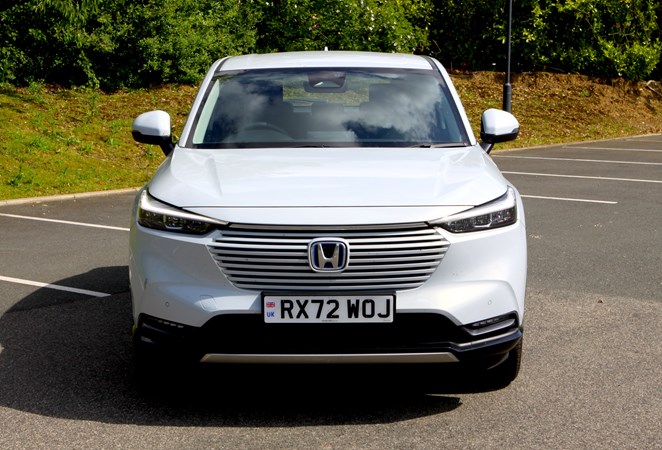
First impressions are of a very stylish performer. Externally, the car looks like a modern and stylish SUV with a sprinkle of ‘Coupe’ as a topping. The interior is large and spacious and we found ourselves not lacking for any room in the rear. From the front the styling looks ‘bullish’ in the way the design of the headlamps and grille interact.
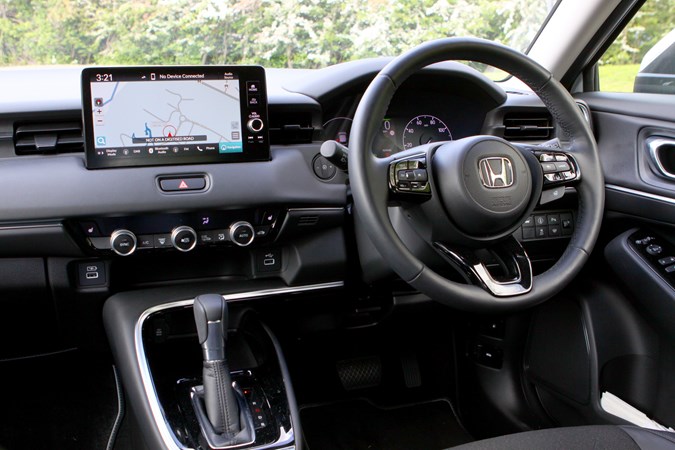
In the boot, the standard space is 316 litres with all seats up which in our opinion is a little on the small side. This can be expanded to 1,290 litres when the rear seats are lowered and also includes the boot/luggage floor box which acts an additional storage compartment.
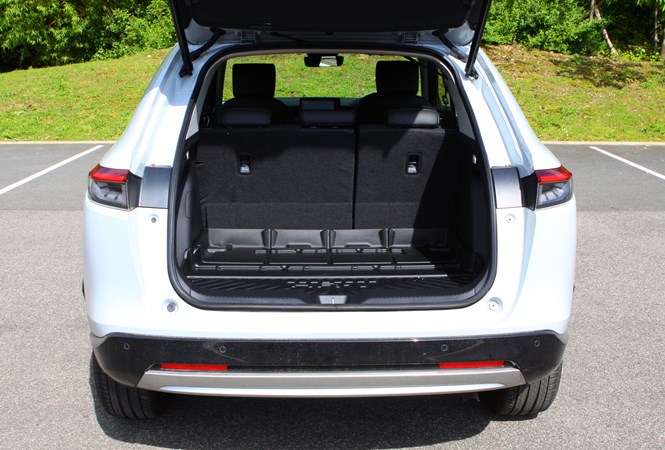
See the full factory Honda HR-V 1.5 e:HEV Advance 5d CVT specifications here.
Update 2: Equipment and Options
As mentioned in the intro, the new HR-V is available in three trim levels. Elegance, Advance and Advance Style. The equipment list of the base spec ‘Elegance’ is super impressive and you can’t really class it as an entry-level car as the amount of kit is stellar.
All three trims share exactly the same specification regarding safety features which includes a Lane Keeping Assist System, Lane Departure Warning and Road Departure Mitigation. Only the Blindspot Info and Cross Traffic Monitor is absent from the Elegance. The most recent Euro NCAP safety test results from 2022 gave the HR-V a four-star rating.
On the security side, all equipment is standard fit on all three trims which includes an immobiliser system, remote central locking, a security alarm system and super locking.
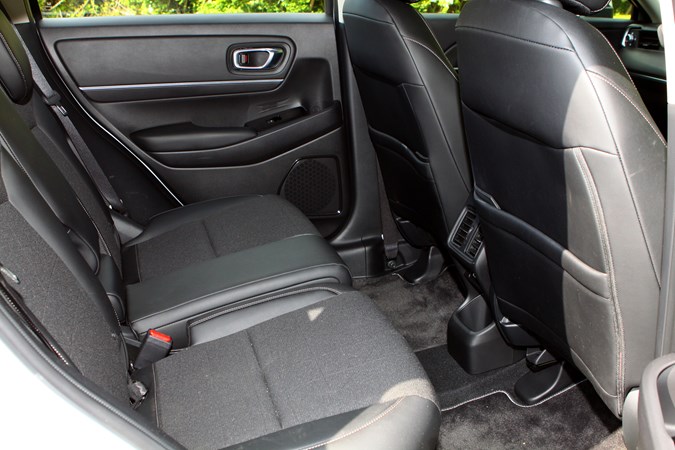
Inside the cabin the HR-V is comfortable with fabric seats which incorporate black synthetic leather outer trim edges which never gave any issues of the infamous numb bum even after an extended long run. Driver aids include a 7.0-inch digital driver display behind the steering wheel which is at the heart of the driver’s controls and monitor of systems.
Consisting two separate screens, the driver can seamlessly shift between the various display modes using a combination of steering wheel mounted buttons and a thumbwheel on the left-hand side of the steering wheel.
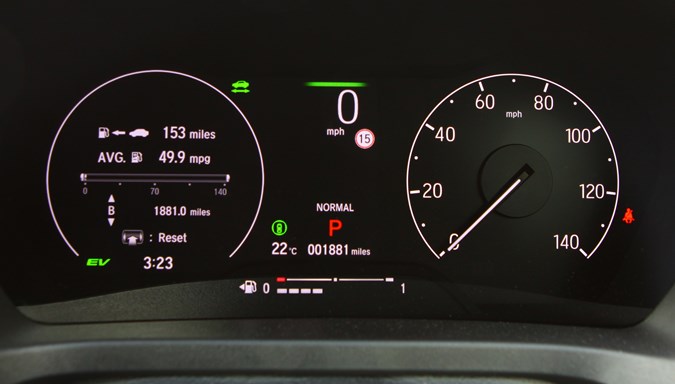
It doesn’t take too long to get used to the workings of the system and it’s pretty intuitive, although from time to time we felt it necessary to disable the over-zealous Road Departure Mitigation Warning system as it seemed to kick in at every opportunity.
The infotainment screen is a chunky 9.0-inch capacitive touchscreen (available on all trim levels) and has a nice resolution and is very easy to use. We found the touchscreen (which is also shared with the Jazz) was nicely laid out and functional but also extremely responsive with virtually no lag.

The software side has been well thought out and looked very logical – I personally found it one of the better systems to use. Together with an excellent user manual (which by the way, is also included as part of the digital on-board apps so to speak) gets a big thumbs up here. Included in the digital package is Apple CarPlay and Android Auto which are available on all trim levels as standard. When reversing, the screen doubles up to enable the user to view the rear-view camera which is a good resolution unit and displays sharp images.
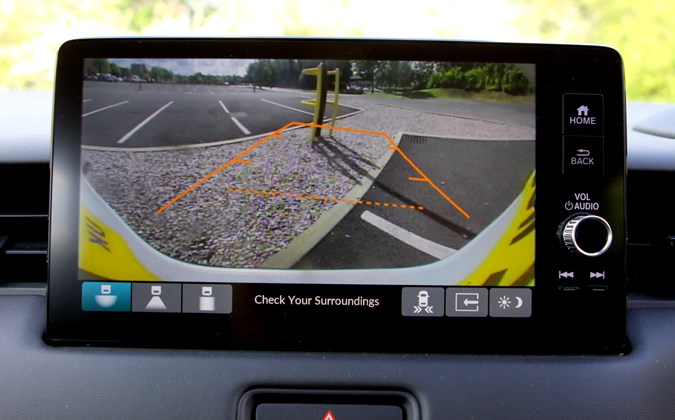
A nice touch is that all models are equipped with 18-inch alloy wheels with premium 225/50 R18 tyres as a standard factory fit feature, although we think the larger wheels do add a little to the already quite noisy environment of the car especially when travelling at speed.
Externally, the car’s rear tail lights stretch across the entire width of the boot and one point to note, especially for passengers wanting to access the rear cabin, is the arrangement of the rear door handles which are recessed behind the outer handle which sits flush to the bodywork. Once you find them (and initially you could be left guessing) – then operation is simple.
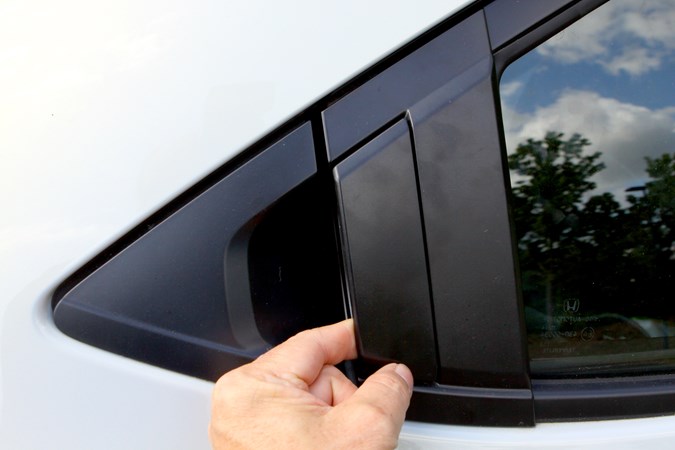
For top-level trim owners, roof rails are fitted as standard which allows for up to 50kg of weight to be transported on the HR-V’s roof. These also provide a sturdy base for adding a roof rack to carry mountain bikes or whatever larger items you may need for a great get away.
The onboard audio offerings do differ between trim levels with the base level ‘Elegance’ having a four-speaker [front/rear/left/right] standard arrangement. This extends to a six-speaker system and front tweeters on the ‘Advance’ model and a further upgrade to ‘Premium Audio Speakers (although there’s no tech details from the manufacturer), an additional centre speaker array and sub-woofer on the Advance Style trim. There’s a USB type-A connector below the climate controls and another USB type port providing low-current power only. However, we were surprised by the lack of a type-C USB port given this is the general modern USB format and has now been around for well over five years.
For drivers out and about after dark, you’ll find all models are fitted with auto headlights, LED daytime running lights, LED headlamps and a high beam support system as standard. Factory fit standard features on the Advance also include LED front fog lights which expand to LED active corning lights on the Advance Style.
We did find it disappointing that there was no option to include a sunroof with any of the trim levels.

At the rear, the tailgate is electronically-operated on all trim levels with hands-free operation on the Advance and Advance Style trims. Space wise, there’s 316 litres available with the seats up and 1,290 litres with them lowered. The small capacity with the ‘seat up’ arrangement may be a challenge even for the weekly shop and we’ll report back here on how we get on in the future, but the HR-V doesn’t offer the larger cargo capacity compared to some of its rivals.
However, Honda gurus have cleverly developed the way the second seating row operates. Referred to as Magic Seats, the entire second row can be lifted to reveal a large storage area which will hopefully alleviate any concerns with overall storage space. Under the rear boot you’ll also find a handy underfloor compartment.
Update 3: The Weekly Shop
Before galivanting off and getting some driving under our belt, we felt that a quick trip to the local supermarket would be a good starting point in getting to know our HR-V just that little bit better.
For example, if you’re out to do the shopping and the school run (collecting a couple of youngsters in the process), then our experience showed you’ll need to get the shopping trip done, dusted and ticked-off before picking up the kids.

Once the (normal) seating positions have been allocated, then you only have a very limited amount of storage in the boot area. Take the rear seats and the small rear under boot storage out of the equation and we could only fit in about 8 standard size shopping bags and a bag of BBQ charcoal into the boot.
OK, it may be enough for some and was certainly good for a shop based around two people, but if this was a family of four, then you could quite easily double that number of bags. You’d never fit it all in without some serious double-stacking of bags and would probably end up crushing some of your items in the process.
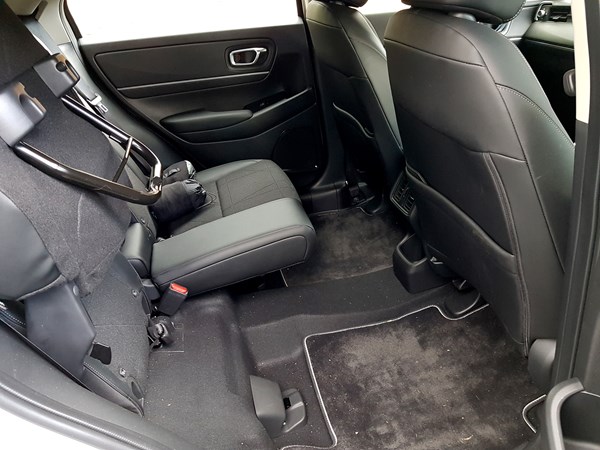
Whilst the rear seats are a clever affair, they only come into play if you have two (or max three) people on board. In this instance the rear seats can be lowered and the additional rear storage room, together with a small underfloor area then shines giving a welcoming 1290 litres. Unfortunately, with the seats in their normal upright position, the storage space shrinks to a mere 316 litres.
Saying that, the range-topping Advance Style model gets just 304 litres because the upgraded sound system takes up additional space using one of the side storage compartments. By comparison, the Skoda Karoq has a 521-litre boot, while Vauxhall’s Corsa small hatchback offers 309 litres.
Update 4: Initial Driving Impressions
For those of us who are used to driving a conventional ICE [internal combustion engine] car, driving a self-charging hybrid like the HR-V means changing your driving style somewhat. When you first press the ‘Power’ button, the cabin remains totally silent as the car initialises itself in ‘EV’ [Electric Vehicle] mode. Apart from the bright and clear visual display on the dash, there doesn’t seem to be much else happening – its spookily silent.
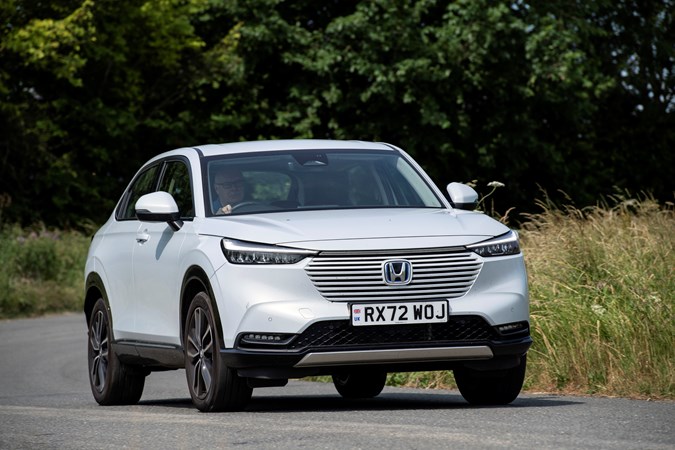
So, moving off my driveway, I managed to cover about 200 yards or so before the petrol engine cut in – and it does so with quite some vigour. It’s a rather chalk n’ cheese affair from a totally silent first few hundred yards to what feels like an ICE car running on full choke when cold and with more than the required amount of throttle. The car feels like it’s being overly revved and remains like this for some period of time.
On the road out of my village there’s a long but steady incline. Here’s where I found the car to be initially both noisy and sluggish, well at least when it was tackling this incline from a cold start.
Moving off up the incline and with a steady throttle of about 30-40%, the car would rev quite fast and loudly. Increasing the throttle to around 60% only seemed to increase the noise and engine revs but didn’t seem to make the car any more responsive. When the car had come up to temperature, the ‘high-revving’ tendency of the power units did reduce slightly but it still felt quite noisy and harsh inside the cabin especially if you needed that little bit of extra throttle.
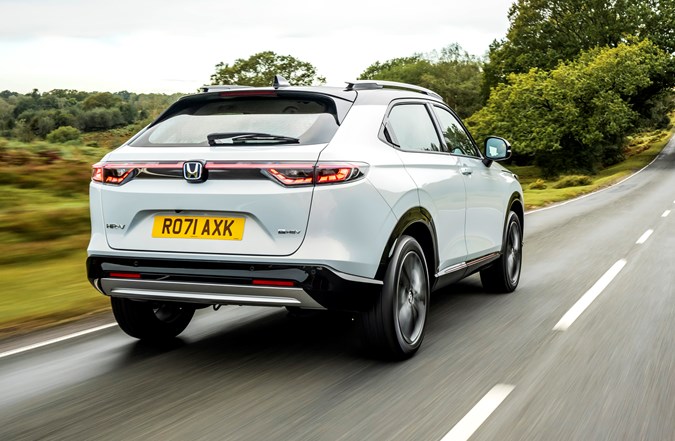
After a few miles of ‘warm-up’ I was eagerly watching the fuel consumption on the dash. Now all of us ‘old-school’ drivers know without reminding that when you throttle back, your fuel consumption will decrease. Honda’s hybrid power unit however did not show that on the dash whilst watching the ‘live’ fuel usage. Under [normal] petrol power, the returned consumption sat at [or was around] the 40mpg level and varying the throttle position did nothing to improve the indicated returned MPG.
The only thing that would coax it into returning a better level was when the car switched to ‘EV’ mode which it did very frequently. The consumption meter would then sit at the far right-hand side, indicating a return of over 140mpg. What I would say is that Honda’s engineers have perfected the way the car achieves this. The transition between the two modes is totally seamless and under normal driving conditions the driver never seems to notice when this occurs.

Out on the road and a 250-mile round trip run to the Wye Valley consisting mainly of ‘A’ roads using the ‘Normal’ drive mode, the car returned well over 50mpg which is on-par with the advertised WLTP figures. We’ve yet to test it out using the ‘Eco’ or ‘Sport’ modes [in ‘Sport’ the petrol engine is permanently ‘on’ and running] but hope to do that later.
The steering is pretty accurate and feels naturally weighted, but the combination of a fairly tall body and a soft suspension means it doesn’t feel especially agile and can be a little soggy going into corners especially if you are keeping up a brisk pace. Predictably, it will understeer if you go in ‘Whole Hog’. Saying that, on good old British roads that have their fair share of potholes and ravines, the setup generally deals reasonably well with most situations but we wouldn’t say the drive was particularly exciting.
What is noticeable though is that the soundproofing in the car seems to be struggling to cope. In ‘EV’ mode, it’s not really an issue as at low speeds there’s’ very little road noise, but as soon as the engine cuts in and you need some power, the dB’s crank up which is exasperated by poor roads, especially poorly surfaced minor roads and in particular similar ropey ‘B’ roads.
The drive although pleasant, didn’t feel that relaxing. There’s the feeling that in the cabin everything is just too busy and not that chilled out. I felt that even after 250 miles over a day, that I’d done a lot more.
We also noticed that enhanced road noise from the 18-inch wheels seemed to add to the experience, which didn’t make life inside any more comfortable. In the cabin it’s a real mixed affair for sure and may not be to everyone’s’ taste.
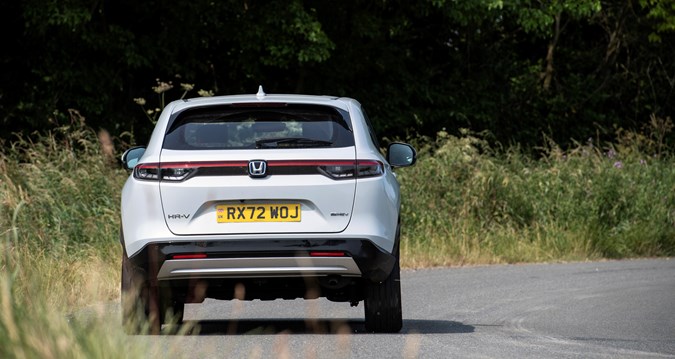
Whilst we’re always up for some interesting and useful tech, we found the fiery ‘Road Departure Mitigation Warning’ was just too intrusive, wanting to get in on the action with even the slightest deviation from the straight and narrow.
On country roads the warning tended to kick in quickly, together with a frequent tug on the steering wheel. This was especially noticed if you needed to move slightly more to the left when allowing for oncoming traffic. This seemed particularly apparent with verges that had long grass from late spring and summer growth.
On ‘A’ roads and major roads, it was less of an issue, but we found ourselves almost disabling it by default every time we began a journey. This became a bit of a chore as it required the selection of 3 buttons [in separate places] which wasn’t so easy, especially if you were on the move.
A permanent ‘disable’ feature would be very useful, if not, a tweaking of the software wouldn’t go amiss.
Update 5: Summing Up – Final Impressions
Well, we never got to take our HR-V on its final long distance road trip. Time just flew by and because the loan was a shorter than expected, before I knew it, it was time for RX72 WOJ to head back to Honda’s press office.
Saying that and during its time on fleet, we managed to get under the outer skin of the HR-V. There’s plenty to like about the car and the build quality, of which Honda has always had a great reputation for, is as expected – but all-in-all, it’s not without its foibles.
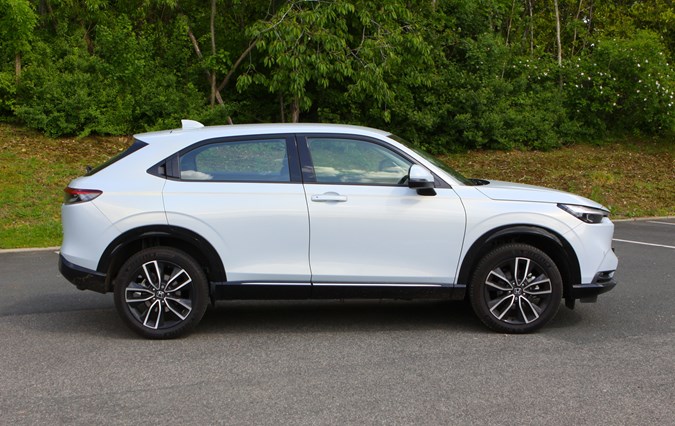
Generally, the tech is top notch, although as mentioned, the ‘Road Departure Mitigation/Lane Departure Warning’ is too aggressive and gets in on the action far too often. It would benefit from some tweaks for sure.
The car exhibits a seamless transition between petrol and electric modes, but we feel that when the petrol engine does cut in, noise levels can be troublesome especially if you’re accelerating hard. In our opinion, the soundproofing lets the car down somewhat and on a long journey the car felt ‘hard work’ to drive and not that relaxing.
One area of contention is the size of the boot. At only 316 litres it’s about the same as the Vauxhall Corsa Hatchback, so you’re not going to cram in too much shopping or luggage and we found that out quite quickly.
A large family weekly shop filled the boot with ease and we needed to double-stack the bags. Whilst dropping the rear seats helped immensely – together with Honda’s ‘Magic Seats’ being prodded into action, you’d struggle to get very much inside if you were seating four people.
The 9-inch infotainment screen in our opinion is excellent and the layout/software and functionality of the whole ‘info’ and navigation package has been very well thought out.
All-in-all there’s plenty of choice where the Honda sits and it’s got some pretty hot competition to beat – although the price of all three models in the range is very attractive especially when you look at the amount of kit that’s included as standard. See the full specifications here.
Out on the road, the HR-V regularly exceeded the 50mpg mark [claimed 52.3] so it’s very economical. We thought the drive though was rather bland and not particularly engaging.
We’d recommend that potential buyers definitely try a test drive first as we feel the cabin and driving experience may not be everyone’s cup of tea.
What we like
- Great tech
- Seamless transition between ICE and Electric modes
- Top-Notch Honda build quality
- Great fuel economy
- Standard amount of kit is impressive
What we don’t like
- An auto box that revs high – especially when cold
- The cabin can be noisy
- Limited storage space – only on par with the Corsa
- Road/Lane Departure warning system is too aggressive
- The ‘drive’ is not that relaxing
Last update: Percy Lawman – August 7th 2023



